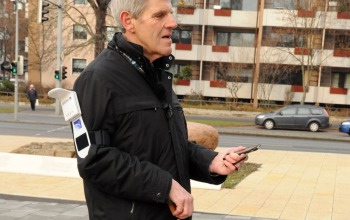
New App Enhances Safety for Blind Pedestrians in Cities

In cooperation with the Technical University of Braunschweig and several partners, Siemens is working on a comprehensive assistance system for visually impaired people. The system is the result of a research project titled InMoBS. Among other things, the solution relies on the data transmitted between the traffic infrastructure and blind people's mobile devices.
Critical situations occur at intersections, for example. Although walk signals usually emit a beeping sound to inform visually impaired people, but they don't know how long the light is green or where exactly it is safe to walk. To provide such information, Siemens enabled smartphones for its car2x technology, which is used to transmit data between cars and traffic infrastructures.
For their walks, many blind people are already using barrier-free smartphone apps that let them navigate through cities with the help of GPS data and digital maps. The InMoBS project uses this technology for its assistance system. which provides its users with an online route planner that they can use at home to find the most barrier-free route to their destinations. The smartphone app emits vibration signals or verbally guides users along this route.
Traffic lights send their information to smartphones
Siemens has been working on technologies and standards for the communication between vehicles (car2car) and between vehicles and traffic infrastructure systems such as traffic lights and signs (car2x) for a number of years. The information is exchanged to improve the flow of traffic. As an example, a car's engine would only shut off automatically if the vehicle is notified that a traffic light would remain red for a certain amount of time.
This communication can also prevent traffic jams and accidents by having a car warn the vehicles behind it of bad road conditions, for example. Researchers at Siemens' global research department Corporate Technology are currently developing software and communications modules known as road side units for the wireless transmission of data between vehicles and traffic infrastructures.
As part of the InMoBS project, the researchers modified the communications software so that the light signal systems transmits their data via the WLAN standard commonly used for smartphones. Moreover, the information transmitted to smartphones is different to that for drivers. To ensure that all users can safely cross streets, for example, the app only emits a signal at the start of a “walk” phase. The infrastructure also transmits the intersection's layout to the app so that the user knows in which direction he or she has to cross the street.
The project partners recently unveiled a prototype of the assistant in Braunschweig. To create the assistant, the partners were able to use infrastructures that were installed in the city for the intelligent mobility application platform (AIM).
Press Pictures: http://www.siemens.com/ct-pictures/in20150104
http://www.siemens.com/innovationnews












